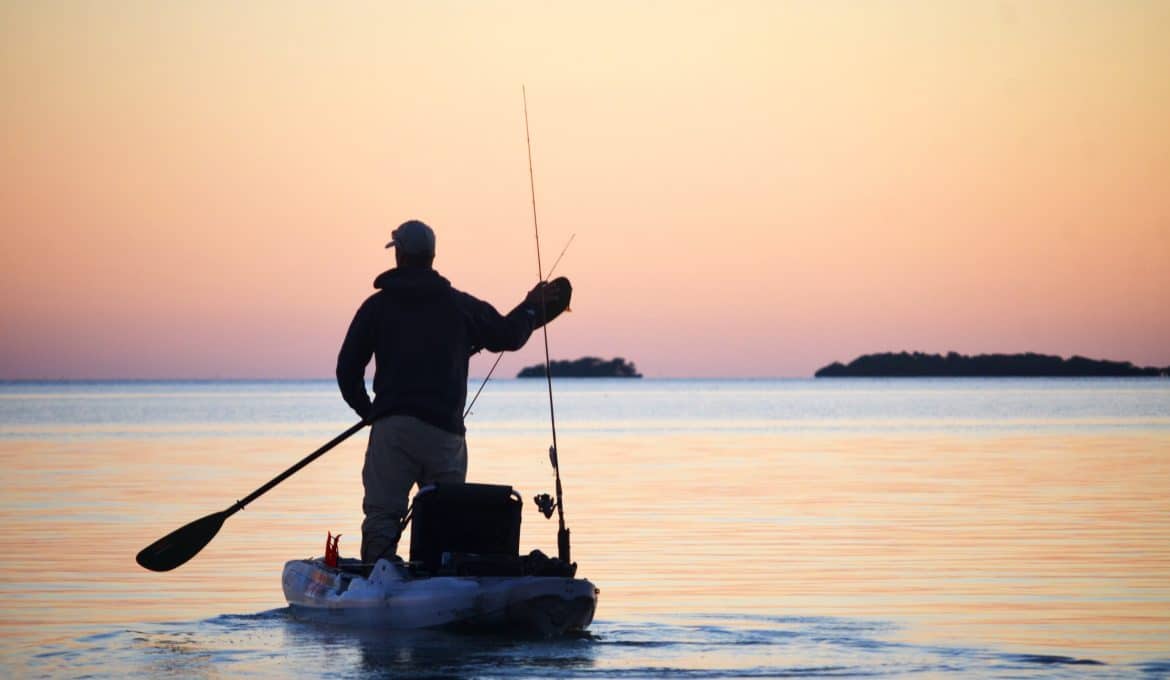There’s nothing wrong with bank fishing. But admit it. You’ve stood on the bank, chucking your baitcaster as far as it’ll go, and you’ve seen those fish well beyond your farthest cast jumping, just itching to grab hold of whatever bait is on the end of your line.
And you can’t reach them.
How do you do it without dropping a pretty serious amount of cash on a nice aluminum boat, even without an outboard or trolling motor? This answer is easy and you’ll love the freedom.
A kayak.
You can take a rod and a small tackle box in any kayak, but if you’re really looking to outfit your boat for a proper floating trip, here are a few things to consider.
The Perfect Fishing Kayak

You’ve got a lot of options in a boat, and a lot of things to consider. The three primary versions are sit-on-top recreational, sit-in recreational, and touring. Any of these will do fine for a fishing trip, though you’ll find more of the sit-on-top and sit-in varieties set up for fishing.
There are a few things to consider. You want a decent amount of space for your gear: one or two rods, a small-to-medium-sized tackle box, water or whatever you want to drink, and a dry bag or two.
If you’re planning to fish primarily in still water (lakes, ponds, or saltwater), many prefer the sit-on-top variety. They offer a little more room to move around, adjust for landing your catch, and should you roll it (set the hook a little too hard, did you?) you can flip it back over without it filling with water.
Sit-in kayaks are preferred for moving water. You stay drier, and they’re lighter—should you have to portage your boat across a sand bar.
Many new kayaks come with pedals to give you more freedom to actually fish. However, those pedals don’t always work as well in shallow water, and you’ll still likely need a handle paddle just in case.
Rod Holders

Rod holders are important for a lot of reasons: they keep your rods separated so you’re not trying to untangle things once you’re on the water; they give you more opportunity to paddle and maneuver; and they give you more space for your feet and other gear.
If you buy a pre-rigged fishing kayak, it will likely come equipped with rod holders. If not, installing them doesn’t tend to be much of a problem.
There are two primary types of rod holders to choose from: flush-mounted and secure-mounted.
Flush-mounted simply tubes which hold the lower handle of the rod, and are usually mounted to the boat with bolts or rivets. Secure-mounted rod holders actually grab your rod, and are ideal if you have a habit of flipping your kayak. They’re usually adjustable (allowing you to keep your rod tip lower), and sometimes clamp onto the lip of your boat for movability.
Seats

A good day on the boat in a bad seat can absolutely ruin your back and butt if you’re in the wrong seat. Lower-cost boats come with molded seats that often have flat seat pads. They’re not great.
Many fishing kayaks now come with adjustable, lawn-chair style seats. They make a day on the water much, much nicer, mostly thanks to the back support. The higher the back, the more the support. Bent knees feel very, very good after a few hours in a boat.
Mesh seating with breathability also has its perks for pretty obvious reasons. (I hope I don’t have to explain why.)
If you have a steady boat that allows for standing, a higher seat makes that adjustment a lot smoother.
Organization
Different boats will have different options for organization and storage. Dry bags are imperative no matter what.
Rear tank wells are ideal for holding the bulk of your rods and gear. If a boat comes equipped with a center console, it’s ideal for small tackle boxes that will give you quick access to swap lures and bait.
Because we’re talking about being out on a boat on the open water, often by yourself, the front of the boat is often ideal for a bilge pump, emergency kit, additional floatation devices, and other items that are just-in-case.
We anglers tend to be big fans of gear. Boats are great places to house some of that gear but remember: you’re responsible for paddling it all around with you. Especially if you’re not used day-long paddles, doing it with a ton of gear is a sure way to get turned off to kayak fishing.
Go light, and don’t overpack your gear, and enjoy being on the water.
What would you bring with you if you were kayak fishing? Leave a comment below!




